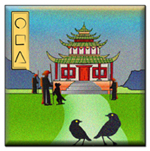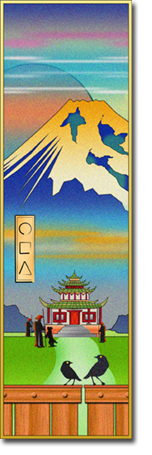On The Way: The Daily Zen Journal
Essentials of Cultivating the Mind Part 3
Hung-jen (600-674)

One who comprehends the mind that is the source of all dharmas always understands everything. All wishes are fulfilled, and all religious practices completed. If you can stop generating false thoughts and the illusion of personal possession and completely discard your preoccupation with the body, then you will certainly achieve birthlessness. How inconceivably wonderful!
Make effort! And do not be pretentious! It is difficult to get a chance to hear this essential teaching. Of those who have heard it, not more than one person in a number as great as the sands of the River Ganges is able to practice it.
Calm yourself with care, moderate any sensory activity, and attentively view the mind that is the source of all dharmas. Make it shine distinctly and purely all the time, without ever becoming blank.
Question: What is blankness of mind?
Answer: People who practice mental concentration may inhibit the True Mind within themselves by being dependent on sensory perceptions, coarse states of mind, and restricted breathing. Before achieving mental purity, such people may undertake the constant practice of concentrating the mind and viewing the mind. Although they do so during all their activities, such people cannot achieve mental clarity and purity, nor illumine that mind which is the source of all dharmas. This is called blankness of mind.

The sutra says: “Sentient beings discern the mind and cross over to the other shore of enlightenment by themselves. The Buddhas cannot make sentient beings cross over to the other shore.”
If the Buddhas were able to make sentient beings cross over to the other shore, then why have we sentient beings not yet achieved buddhahood? We are drowning in the seas of suffering simply because we are not completely sincere about seeking enlightenment
Make effort! Now, in this very lifetime, you have had an opportunity to hear this teaching. I have related it clearly; it would be well for you to understand what I say. Understand clearly that maintaining awareness of the mind is the highest way.

To remain unmoved by the blowing of the eight winds of good and ill fortune is to have a truly special mountain of treasure. If you want to realize the fruit of nirvana, then just respond to all the myriad different realms of your consciousness by activating transformations as numerous as the sands of the River Ganges. One’s discrimination of each instant is so skillful it seems to flow.
Applying medicine to fit the disease, one is able to stop generating false thoughts and the illusion of personal possession. One who can do this has transcended the world and is truly a person of great stature.
Having explained these things, I urge you in complete sincerity: Stop generating false thoughts and the illusion of personal possession.

Question: What do you mean by the “illusion of personal possession?”
Answer:When only slightly superior to someone else in some way, one may think that this superiority is due to one’s own achievement. To feel this way is to be sick even while in nirvana.
The Nirvana Sutra says: “This is likened to the realm of space, which contains myriad things. Space does not think to itself, I am doing this.”
This is a metaphor for the two teachings of eradicating the illness and practicing the truth, the concept of extinguishing the illusion of personal possession and the “adamantine samadhi.”
Gently quiet your mind. I will teach you how to do this once again: Make your body and mind pure and peaceful, without any discriminative thinking at all. Sit properly with the body erect. Regulate the breath and concentrate the mind so it is not within you, not outside you, and not in any intermediate location.

Do this carefully and naturally. View your own consciousness tranquilly and attentively, so that you can see how it is always moving, like flowing water or a glittering mirage. After you have perceived this consciousness, simply continue to view it gently and naturally, without the consciousness assuming any fixed position inside or outside of yourself.
Do this tranquilly and attentively, until its fluctuations dissolve into peaceful stability. This flowing consciousness will disappear like a gust of wind. When the flowing consciousness disappears, all one’s illusions will disappear along with it, even the extremely subtle illusion of bodhisattvas of the tenth stage.
When this consciousness and false cognition of the body have disappeared, one’s mind becomes peacefully stable, simple, and pure. I cannot describe it any further. Think about this carefully, for this is the truth.
Excerpted from The Northern School and the Formation of Early Chan Buddhism – John MacRae





Hung-jen was the 5th patriarch of Zen, best known for passing the robe and bowl to Hui-neng whose teachings became The Platform Sutra, the only sutra not ascribed to the Buddha. The piece above contains some clear instructions on meditation. It is uncommon to find much direct advice given in ancient times. These instructions were given to monks training with him, and the basis of this treatise consists of questions and answers.
It is always surprising to find the common threads of practitioners throughout time; some of the questions are ones we might have asked. Some sound like intellectual distractions a person is caught up in. No matter, we can learn from all of them.
Every master or teacher functioning in their highest role is trying to help shake the person’s attachment to self and form. This as we all know is no small task. Each teacher develops their own style, some which seem outrageous, but all share a common purpose.
“Sentient beings discern the mind and cross over to the other shore of enlightenment by themselves. The Buddhas cannot make sentient beings cross over to the other shore.”
In the end it is up to us to rein ourselves back in from the racing stream.
Great effort, no goal,
Elana, Scribe for Daily Zen